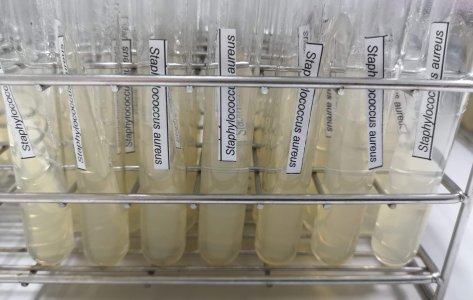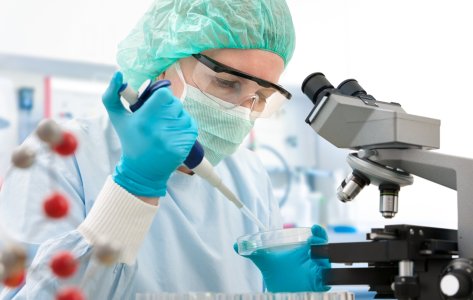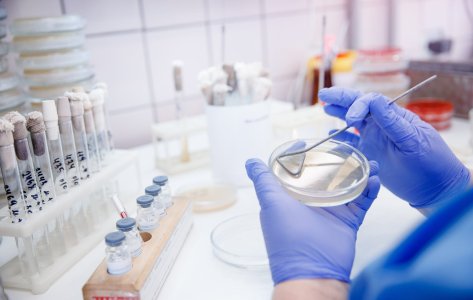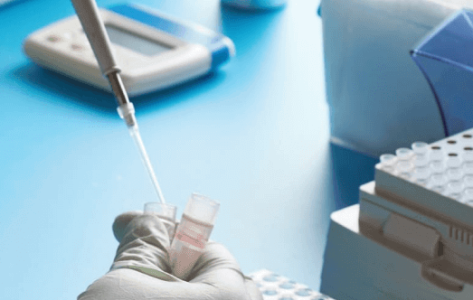- Swiss testing laboratory
ASTM E2274: 2016

Hassle-free testing experience
Need to get a product tested? No worries! To and fro logistics are on us; we collect your products, test them and, deliver them back to you.
Related tests for you
Quick understanding of the test
ASTM E2274: 2016 - Evaluation of Laundry Sanitizers and Disinfectants
Application
- Klebsiella pneumoniae (ATCC 4352)
- Staphylococcus aureus (ATCC 6538)
- Pseudomonas aeruginosa (ATCC 15442)
- Sterile fabric carriers are inoculated with test inoculum and dried.
- The dried inoculated carriers are transferred into a single-wrapped spindle, which is, in turn, transferred into an exposure chamber.
- The fabric carriers are removed and added into a neutralizing broth, followed by the addition of wash water, agitation, and filtration.
- The filtrate is plated and incubated on agar plates to enumerate the remaining viable bacteria.
Sub-method for testing sanitizer efficacy:
- The neutralizing broth and the neutralized wash water are serially diluted.
- Both sets of dilutions are plated on agar plates and incubated.
- Following incubation, the colonies are counted and the number of organisms on the test fabric carriers and in wash water is compared to control.
- Simulates real-world laundry conditions for practical and reliable assessment.
- Demonstrates product compliance with regulatory standards.
Turnaround Time
Passing criteria
- At least 4 log reduction for bacteria and mycobacteria.
- At least 3 log reduction for fungal spores and yeast.
Do you have a product that needs testing?
Abstract
ASTM E2274 is a standardized laboratory method that provides guidelines for assessing the antimicrobial properties of laundry sanitizers and disinfectants specifically intended for use in top-loading automatic clothes washing machines. By simulating real-world washing conditions, this method produces quantitative data on a product’s ability to reduce or eliminate microorganisms, primarily bacteria, from fabrics during laundering.
While the standard is primarily designed for evaluating bactericidal performance, it can also be adapted to test the effectiveness of laundry sanitizers and disinfectants against fungi and viruses, broadening its relevance for manufacturers with multi-claim antimicrobial products.
ASTM E2274 complements the ASTM E2406 test method, offering a comprehensive approach for verifying laundry disinfectant performance under conditions that closely mimic typical household or institutional laundering practices.
Test Conditions & Requirements

Test Method
- Three sterile fabric carriers are inoculated with 0.03 ml of test inoculum.
- The carriers are dried in an incubator at 35 ± 2 °C for approximately 30 minutes.
- The dried inoculated carriers are then aseptically transferred into the folding of a single-wrapped spindle.
- The spindle is aseptically transferred into a sterile exposure chamber.
- The fabric carriers are removed from the spindle and placed into a neutralizing broth.
- Wash water is added to the neutralizing broth and agitated. This step completes the exposure time.
- The total volume of wash water containing neutralizing broth is filtered. The filtrate is plated and incubated on agar plates to enumerate the remaining viable bacteria.
- The results are reported as growth (+) and growth (-).
- Gram staining and streaking techniques are used for the identification of bacteria.
Sub-method for testing sanitizer efficacy:
- The neutralizing broth and the neutralized wash water are separately serially diluted.
- Both sets of dilutions are plated on agar plates and incubated for 48 ± 2 hours at 35 ± 2 °C.
- Following incubation, the colonies are counted and the number of organisms on the test fabric carriers and in wash water is compared to control and the percentage of microbial reduction is deduced.
Acceptance criteria
To pass the test, the product must exhibit at least 4 log reduction in the count of bacteria and mycobacteria and at least 3 log reduction in the count of fungal spores and yeast.
The results of the test are expressed as a percentage reduction of test organisms on carrier fabric and wash water in relation to the control.
Importance
Fabrics used in medical areas, laboratories, and pharmaceutical industries are likely to be contaminated due to considerable levels of soiling including blood, urine, and sweat. These contaminants are capable of supporting the growth of harmful microorganisms thus increasing the chances of infections and cross-contamination. Hence, it is essential to clean these fabrics before use. This test validates the antimicrobial efficacy of laundry sanitizer or disinfectant products used to clean the fabrics.
Conclusion
Microbe Investigations Switzerland (MIS), we offer a wide range of antimicrobial testing services for all kinds of disinfectant and sanitary products under one roof. We focus on giving genuine and affordable services to our clients while maintaining excellence. Our team of experts performs the tests completely in accordance with standard operating protocols and keeps track of test activities to provide coherent test results.
To get more information on ASTM E2274 testing, get a free consultation from our experts.
Frequently Asked Questions

DR. Martinoz Scholtz
ASTM E2274 provides a test method for the evaluation of the antimicrobial efficacy of a test reagent or formulation of laundry sanitizers and disinfectants used to disinfect contaminated fabrics.
ASTM E2274 test is designed for laundry detergents, additives, and sanitizers used in top-loading automatic clothes-washing processes.
It takes 4-6 weeks to complete this test.
At Microbe Investigations Switzerland, we perform this test using the following bacterial strains: Klebsiella pneumoniae (ATCC 4352), Staphylococcus aureus (ATCC 6538), Pseudomonas aeruginosa (ATCC 15442).
The purpose of this test is to evaluate the antimicrobial efficacy of laundry sanitizers and disinfectants for use in top-loading automatic clothes washing operations.
The test measures the reduction in bacterial population on the fabric to assess the effectiveness of the laundry disinfectant.
The performance criteria include the reduction in the bacterial count on the fabric and in the wash water following a single wash.
The test ensures laundry sanitizers and disinfectants are effective in reducing microbial load on fabrics thus reducing infection and contamination risks.
The benefits of this test include ensuring the safety of the product and meeting regulatory compliance.
Commonly tested materials: bleached, desized cotton print cloth, plain-weave, no bluing or optical brighteners.
Yes, this test can be used/pertains to both residential as well as commercial laundry products.
Meet the best of the blend of
R&D, Efficacy Testing,
Innovation and Passionate
Experts at MIS.





Explore More
Did you know there are
Antimicrobial testing is important to
Antibacterial efficacy testing is an
Let’s face it, we are






